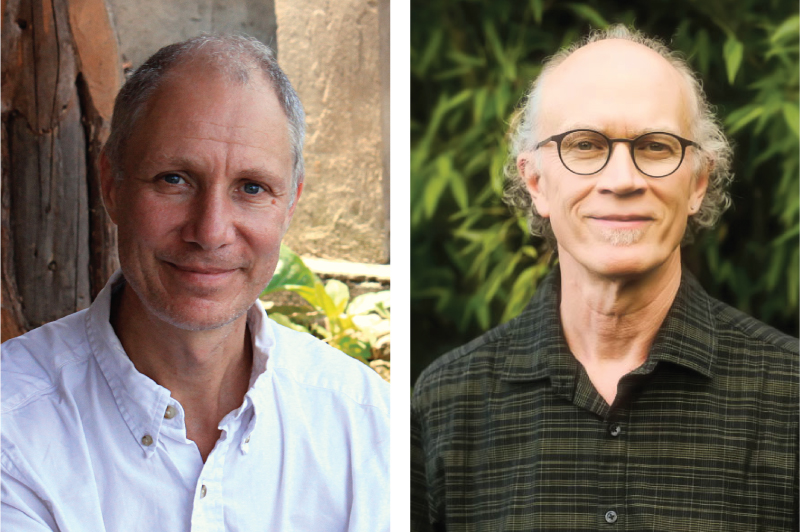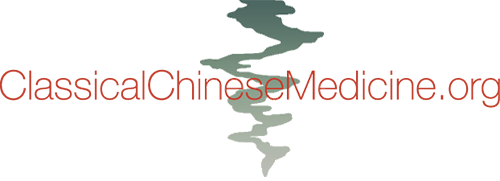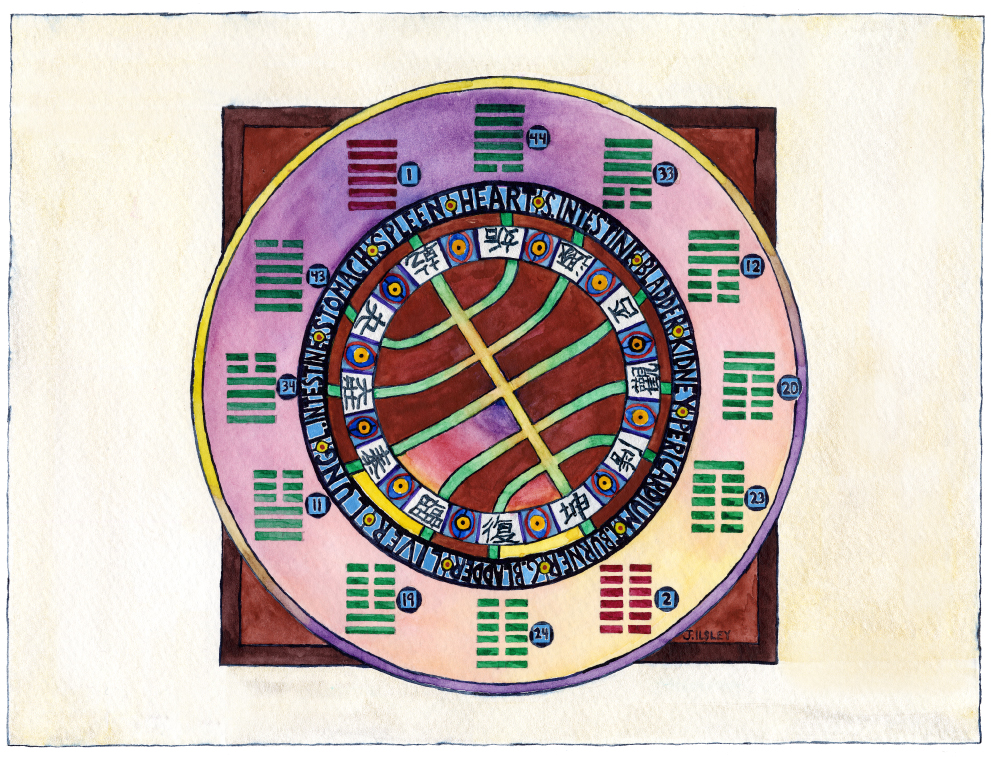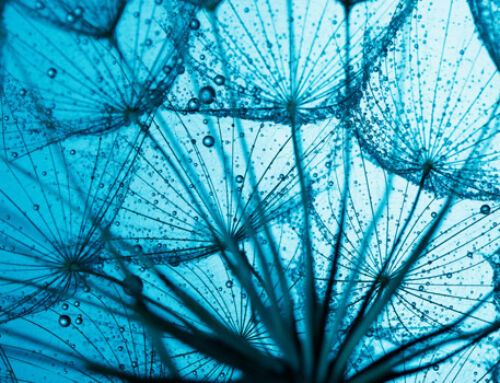AN INTERVIEW WITH HEINER FRUEHAUF AND BOB QUINN

Heiner Fruehauf and Bob Quinn
Heiner Fruehauf recently sat down with his colleague Bob Quinn to discuss the role of ancient cosmology, symbolism and dreams in the context of clinical diagnosis and treatment (August 2022).
QUINN: Thank you for making time for another interview! I always enjoy these talks and hope others do as well. The topic I want to tackle this time is one I’ve thought about for a long time because of my personal interest in dreamwork. I have studied with Jeremy Taylor since 1993 and am very interested in developing this material in the field of Chinese Medicine. In fact, our colleague Laurie Regan, ND, PhD, the former Dean of the College of Classical Chinese Medicine at NUNM and I have our Classical Chinese Medicine Dreamwork Certificate Course going live in November. This is something that Jeremy Taylor always wanted me to do. He saw the value of this symbol work and the need for it. When he died suddenly a few years ago I was sad that you and he had never had the chance to meet.
I know you’ve written about the role of dreams yourself in the past, and your writings have been a big help to me. This topic, in a sort of tangential way, ties in with an academic subject that is unique to our Classical Chinese Medicine program here at National University of Natural Medicine—I’m referring to your Cosmology and Symbolism classes. Between the basic and advanced classes in this series students encounter a lot of profound information. NUNM’s course of study in Chinese medicine is really a stand-alone program in this respect. If other schools are teaching similar classes, they are likely using your research. No one else, at least not in the Western hemisphere, has really explored what you have explored.
I’ve been a clinical supervisor at NUNM for close to ten years now. The only time I’ve seen students incorporate this cosmology material into their treatment approach is when the patient happens to share a dream. When presented with a dream, some of our students are quite adept at identifying images or symbols they encountered in your classes. An example that springs to mind is a patient who dreamt of a lake in the middle of the desert, prompting a student to explain that this is an image belonging to the realm of symbols associated with the Stomach organ-network she learned about in your classes. There are numerous other examples like this that have taken place in my clinic shifts. The phenomenon alone is fascinating already. What you are teaching in these classes, I think, is part of the collective unconscious as Carl Jung would call it. The patients who relate their dream images typically have very little knowledge of Chinese Medicine or of Chinese culture in general. Yet their dreams lend themselves to this kind of symbolic interpretation. We can bring this point into our discussion in a moment, as well. I should note, though, that while students tend to say that your classes are their favorites in the entire program, this material appears to inspire their diagnostic thinking only occasionally. What I want to get at is this: Students love the subject matter but don’t know how to bring it alive clinically. Yet you yourself use this material all the time; I have worked in your clinic with you.
It could very well be that I am just seeing these interns at an early stage in their clinical education. It is possible that ten years down the line they will in fact approach many of their cases through the lens of this ancient yet timeless symbolism. It could also be that new interns don’t yet have the confidence to frame the clinical phenomena they encounter in this mythopoeic way, or that they are still struggling with some of the basic elements of Chinese medical practice such as point location and needling techniques. That is all possible, but I think there is more to it. Our worldview, despite recent scientific advances that point in a different direction, is still predominantly materialistic. What you are proposing in your Cosmology and Symbolism seminars, however, is an entirely new way of looking at the world. There are many scientists whose discoveries resonate with your message. I wonder what you have to say about this situation? Is there any help for people who are trying to make the leap to a place where the ancient science of symbols can come alive and inform the process of clinical decision-making?
HEINER: Yes, thank you, many different thoughts come to mind prompted by your very relevant questions. At this stage of my life, I have been i researching symbols as they relate to the practice of Chinese medicine for almost 25 years. During this time, I have seen some of my other interests come and go, but this topic has captured me to the point where I want to become more deeply involved every year. From an academic perspective, I could say that this has really become my life’s work. Different reasons motivated this development. First and foremost, whenever I encounter a new student cohort, I tell them right away that I am a sinologist by training and thus approach this medicine from the perspective of a poet, a literature scholar, a humanities major, and a researcher of all things East Asian—rather than viewing our profession and its clinical capacity through the lens of a medical technician. I then emphasize the following: Despite this choice of exploring the clinical practices of Chinese medicine before the backdrop of Chinese philosophy and culture, I wish to emphasize that I am standing before you in this seemingly highly theoretical class to help you become the best diagnostician and clinician you can be—it is, in fact, the only reason why I am choosing this approach.
Secondly, Confucius is said to have made the following statement toward the end of his life when asked what he would do if he had another 70 years to live: He responded that he would exclusively immerse himself in the science of yi 易, the science of symbols as introduced in the Yijing 易經 (The Classic of Symbols). This topic is what we explore in my Cosmology and Symbolism class series. There we “excavate” and delve into the trove of imagery used in scientific discourse 2,000+ years ago when the Huangdi neijing 黃帝內經 (The Yellow Emperor’s Classic of Medicine) was created, culminating several centuries later in the work of China’s premier alchemist Wei Boyang 魏伯陽, specifically his Zhouyi cantong qi 周易參同契 (The Seal of the Unity of the Three as Revealed in the Yijing). Alchemy is the great work of the ancients, bringing to light the invisible strings that tie together the energetic movements of the macrocosm and the corresponding gestures of the microcosm in an eternal dance of resonance. That is what this work has been for me and my students: decoding symbols like the twelve Earthly Branches (dizhi 地支), the 12 Tidal Hexagrams (xiaoxi gua 消息卦) and other symbolic materials, which at first glance are not overtly medical in nature but were used in Neijing times to define and illustrate the function of the twelve organ networks. During the seven-century period marked by the lives of Confucius and Wei Boyang, the brightest thinkers in China regarded this endeavor as the highest level of science. There is ample precedent, therefore, for Chinese medicine practitioners to immerse themselves in the science of symbols.
This phenomenon has certainly come true for me: The deeper I have delved into this topic, the more important it has become in my life. I grew up in a German family of physicians who were adamant about two educational priorities: 1) Teenagers were generally exposed to some training in ancient philology, specifically Latin and classical Greek, even though neither language is currently spoken anymore, and 2) Music was regarded as an essential aspect of education. These elements were seen as especially important for a career in medicine, because both knowledge and intuition are required in this most complex field among the sciences. The study of ancient languages, while not directly applicable in the modern world, was intended as a cultivational device. The adolescent brain is like a sponge eager to expand by continuously establishing new neurological connections—connections that can be used later in life to discover relationships that remain invisible to the untrained mind. The goal is to cultivate a more flexible brain, by developing neural pathways that can maneuver and comprehend the web of connections that eventually defines our reality. I know from experience that this educational approach can indeed change the way we look at the world. I believe it should be an important feature in the enterprise of educating holistic practitioners.
We use the term “holistic” all the time, but it often remains unclear what this term really means. For me, it implies the use of a methodology that creates unity rather than separation. Modern science and its favorite offspring, Western medicine, has made the business of exacting differentiation its main focus: bacteria, viruses, subclasses thereof, etc. Working with symbols uses a contrasting approach to defining reality and making sense of the clinical situations we encounter. In the diagnostic procedure of Chinese medicine, the 10,000 constitutions and the 10,000 diseases are characterized via a unifying denominator, such as Fire or Wood imbalance, or Taiyin Syndrome. In a medical practice based on holistic parameters we look for energetic commonalities in the highly diverse diseases we encounter. This process requires an appropriate language and system of categorization. Furthermore, this holistic methodology connects us to the ancestral roots of our field, a way of describing the world that we find in the Neijing and other ancient medical classics. And then, of course, there is the phenomenology and purpose of xiang 象 itself: symbols were always seen as the visionary borderland that connects the spheres of the immaterial—spirit and energy—with that of form and matter. We are thus faced with many unspoken contradictions in the standard way that our medicine is transmitted today. Prospective students are often drawn to Chinese medicine because they want to learn how to work with the vital energetic currents of the body, which requires that we are able to read and diagnose this non-material realm first. We desire to treat at the level of qi 氣and shen 神, but the diagnostic methods we generally start learning during the first two years of Chinese medicine school have become similar to the educational approach of Western medicine–that of memorizing the anatomy, biochemistry and physiology of the body’s structural organs rather than embarking on a deep exploration of the functional lens that the creators of Chinese medicine had in mind when defining organ network characteristics. Ancient scientists in China, India, Egypt and elsewhere divided the body’s multidimensional and intricately connected functions into 12 powers that resonate with 12 macrocosmic impulses unfolding over the course of 12 months in nature. Since most of us cannot accurately read energy directly, the creators of most ancient medical systems relied on the science of symbols, utilizing material imagery to signify immaterial processes. The ability to recognize and decode symbols is therefore important for students of our medicine, whether it is by understanding the inner meaning of iconic images such as the tiger or the dragon, or by feeling the undulating pattern of the pulse, or by observing the variegated signs that your body itself produces, for instance pimples or moles in different locations. All of these can be regarded as a type of sign, a symbol that expresses the energetics of the patient’s body in the domain of the visible. Learning the language of Chinese cosmology is a rudimentary training in ancient symbol science, meant to create a foundation from which students can then move forward in a more flexible way to categorize the diseases or constitutions of their patients. As we improve this particular skill set, we should be able to synthesize the diverse quality of incoming information in the symbolic way of the ancient wisdom teachers. This sort of Confucian exercise, then, becomes more than just a diagnostic tool, but a way to cultivate and expand the capacity of our brain. While I don’t necessarily expect my students to exhibit a mastery of these symbols in a clinical context right away, many people have commented over the years that graduates from the College of Classical Chinese Medicine tend to think better on their feet when compared to those from other schools. I believe, therefore, that this sort of philosophical training, if you want to call it that, this working with symbols can be similar to the cultivational effect of qigong exercises. While students also learn quite a bit of qigong during their time at the College, you don’t really see much practical application in a clinical setting, like specific movements being prescribed for particular disorders.
QUINN: Other than qigong shaking…
HEINER: Yes, other than the qigong shaking exercise, which is easy to teach by and to beginners. Nevertheless, after 30 years of instruction we still wish to keep this relatively large number of qigong practice hours in the curriculum. We feel that the aspect of self-cultivation is most important for helping students mature, but also to help them diagnose and treat on the more subtle levels of energy and spirit. This type of cultivation is as important as the training in the ancient language of symbols. Overall, I can affirm that there is a significant albeit indirect effect that results from the systematic working with symbols. In addition, I concur that there is a direct clinical benefit in the form of an increased ability to interpret dreams.
When it comes to my own clinical practice, I can say without hesitation that it is this system that sustains me on all levels. At this stage of my life my most important mentors are too far away for regular contact, and most have passed on. In their absence, it is the continuous immersion in the symbolic record of ancient China that makes me a better practitioner every year. It enables me to receive new insights, not just abstract philosophical ones, but often on a very concrete level. For example, the design of the Classical Pearls series of products has been created before the backdrop of the 12 “archetypes” of nature mentioned above. This process has brought my symbol and cosmology teachings down to a very practical level in my prescription of plants and other medicinal substances. My own way of symbolic thinking is reflected in the Classical Pearls formulas.
In my clinic, we work with our patients by conversing with them first. This is, of course, common procedure for most practitioners in our profession. My words are therefore the first medicine patients receive from me. With my words, I try to give my patients the “story” of what is going on with them on the formative planes of energy and spirit. The language and images I use in this process are for the most part derived from my extensive forays into the ancient science of symbols. Otherwise, there is no story. There is just “you’ve got kidney or liver inflammation;” you look at their lab reports and give them your interpretation of something they have already heard.
QUINN: And they want to know what your anti-inflammatory strategy is…
HEINER: Indeed! While I will integrate this sort of technical information, I rarely prioritize this way of looking at cases in my clinic. I generally avail myself of the opportunity to tell the patient what their overarching storyline is, and what their weaknesses and strengths are in their current situation. In this way, constitutional sensitivities can be recognized and their related benefits brought into the light. This work, in sum, enables you to initiate the healing process through relating individual situations to the archetypes of nature, similar to what I have witnessed with Sufi sheiks or Chinese storytellers in the Confucian tradition, for instance Wang Fengyi’s 王鳳儀 Shanren Dao 善人道 system. The patient, in recognizing that there are universal archetypes at play in their life, comes to feel that they are not alone with their crises and health challenges, but that others have gone before them, and that they can draw deep insights from that in the process of overcoming their own challenges.
QUINN: Perhaps you can touch on the organ clock material that is such a focus in your Cosmology and Symbolism classes, just to give a practical example?
HEINER: One thing one recognizes immediately when studying the organ clock is the importance of multidimensional relationships formed by the organ networks. Most Chinese medicine students can identify a Wood or Fire or taiyin imbalance, but clinical treatment is rarely focused on a single organ network or a simple 5-Phase Element or Six Conformation pair. Classical Chinese treatment methodology generally suggests an indirect approach to organ network imbalances. Just because a problem is manifesting itself in the liver, it may not be the best strategy to choose just Liver channel points or to prescribe a mono-dimensional formula that directly and primarily impacts the Liver. The Neijing already pointed out that if there is a problem on the right, you needle resonant points on the left. If there is a problem above, you treat below. The same principle applies in the symbol-based approach to diagnosis, as well. You are regarding an organ as part of a network of relationships, for instance not just Lung/Large Intestine Metal, but there are also the Six Conformation designations of every organ represented on this clock, as well as the so-called organ clock pairings that are often forgotten.
QUINN: Not on my shifts.
HEINER: (Laughter) That I believe! Lung-Bladder pathology, for instance, is common, as are issues surrounding the Liver-Small Intestine clock pair. Most addictive behavior, moreover, appears as part of the situational pathology of the Stomach-Pericardium type. These two organ networks are all about issues involving food and sex. Most attachments originate from here. Fertility and DNA replication issues, moreover, are typical pathologies of the Large Intestine/Kidney pair.
QUINN: And there are yet deeper pairs hidden in the clock?
HEINER: Yes, along with other symbols Han dynasty scientists designated the yin-yang amplitudes present in each of the 12 clock positions through 12 hexagrams of the Yijing, the so-called 12 Tidal Hexagrams. By identifying hexagram dyads another layer of relationship between the clock positions and their related organ network emerges. For instance, Hexagrams 43 and 44, which express the energetics of the 3rd and 5th months of the year, are a pair, thus revealing a close relationship between the Stomach and the Heart. The Large and Small Intestines are paired in this way, as well; so are the Kidney and the Liver. The decoding of this intricate web of relationships involving organ functions can help us tremendously in the process of diagnosis and treatment, no matter whether we work with acupuncture or with herbal formulas.
QUINN: Let’s shift gears. We’ve established that the key manner in which this symbol science and cosmology material might work its way into the clinic is that students are changed somehow on a deeper level through this study. It would follow then that all of their clinical encounters would change in character.
I want to bring in an example of a chronic Lyme patient that will tangentially touch on your work with Gu Syndrome (note: Heiner’s research on Gu Syndrome is explored in a variety of other conversations with Bob Quinn and other interviewers). I want to describe an elderly patient and her dream. At the time of the dream, she was perhaps 70-75 years old and not yet my patient. I think the dream shows how the type of Chinese symbolism and cosmology that you teach can potentially show up in the subconscious plane. Dreams can also interface our personal symbol systems with universal archetypes. I’ll try to be brief in telling it. At the time of this dream, the patient did not know that she was suffering from chronic Lyme disease. She was terribly sick, even suicidal, and at her wit’s end. Her nerve and joint and muscle pain was off the charts and moved constantly from one place to another, she couldn’t sleep, she couldn’t think straight, her memory was gone, her emotions were a rollercoaster of anxiety and depression, and she was gaining weight. You get the picture, as it is a fairly common one for chronic Lyme. And then this dream appears.
In the dream this patient is together with her mother in a small wooden rowboat on a narrow jungle river. The foliage at the sides of the river rises so high and abruptly that she has the sense of being in a green canyon. The boat comes around a bend in the river and off to the side she sees a native village. She movest onto shore there and walks up to the village where there are some people. At this point in the dream her mother is no longer seen. She meets a “witch doctor” at the top of a small rise. He looks the part with a grass skirt and a bone through his nose. To the side is his hut and she sees it is full of wicker baskets with lids. She walks into the hut, lifts a lid, pulls out a poisonous snake and bites its head off. This is the end of the dream. She was horrified and considered this dream a traumatic experience. She had worked her entire adult life in animal rescue. She would never in her waking life do that to a snake.
If we step back, though, we see so much of your symbolism material here. We don’t need to take the time to go through it exhaustively. The snake is an animal symbol associated with Tidal Hexagram One, comprised of six yang lines. It is associated with the Spleen organ network. Furthermore, we’ve got water in the river. Is it a reference to Kidney-Water or is it pointing to the Lung, as the “Upper Source of Water?” We could go into that if we had time. Then, at the beginning of the dream, we’ve got a symbolic representation of Liver constraint—narrow, tall green sides, wooden boat. I started my therapy for this patient with Chaihu Jia Longgu Muli Tang 柴胡加龍骨牡蠣湯, without modifications. It produced near miraculous results for three months. It took that long before I needed to change it. It brought her emotions rapidly under control, and once that occurred, many other symptoms improved enough that she had hope again and could start to re-engage with life. Just as these images initiated her dream, they also pointed at how best to begin her treatment. Where did she ultimately end up? Well, this relates to other interviews we have done on Fire Spirit School prescribing and the use of aconite.
The last part of the dream has her grabbing a poisonous snake. What part of the snake does she intuitively know that she needs for her medicine? The head! The head is yang. The snake itself we said is pure yang, as expressed by Hexagram One. This is her medicine, and you could not find a better symbol for Fuzi 附子 (aconite). When I finally prescribed her the first aconite-based formula, the changes were so positive that I could not believe them. She bought a few horses and started to ride again. Then she started to bring poor kids, who otherwise had no access to horses, to the barn and taught them to ride. She started not one but four spiritual book groups that met in her living room weekly. Her transformation—a key part of Spleen symbolism—was astonishing. I bring up this example because it clearly shows how the archetypal symbols you are researching as part of your cosmology work can show up in everyday life and not only influence treatment, but actually direct the treatment. This is not the case with all dreams of course, but here is an obvious example.
HEINER: Fascinating dream, rich in symbolic content.
QUINN: A few other minor points. Dreams often contain puns or various kinds of word plays. This patient had seen so many doctors and specialists trying to get a diagnosis and some help. She no longer knew WHICH doctor to go to. She meets in the dream a WITCH doctor. It is almost funny. And what is the dream doctor, how does he practice? He lives close to earth, so we can assume he uses medicines from the jungle. When I worked the dream with her, she decided to work with me as her herbalist. I am not a witch doctor, but symbolically there is the association. I too work with herbs, some of which do undoubtedly come from a jungle. I too look to nature for my guiding principles. Anyway, I thought I would bring this into our discussion because our students are able to do this kind of work with patients in their clinic.
So, we are talking about two ways that your cosmology material can potentially inform clinical practice here. One you talked about already, when you discussed how the study of cosmology can change a person’s worldview. The second way we see in this example, how these symbols can show up in patient dreams, which is precisely the focus of Chapter 43 in the Huangdi neijing lingshu 黃帝內經靈樞. I leave it up to you to comment here on a number of points. Universal archetypes might present in different patients in a different way, and we need to have the diagnostic flexibility to recognize those individual alterations. In other words, the symbols as they are taught in your classes provide a theoretical foundation, but they are by no means a straitjacket. For instance, as Joseph Campbell and others have pointed out before us, the symbolism of dragons was quite different in China and Europe. How do you think this feature plays out in this dream here? At this point I’ve worked on over 100 Lyme patient dreams, and all of them have been so helpful in the process of diagnosis and treatment design.
HEINER: This example makes total sense to me. We all experience the dream state at night, but we also have waking dreams. In the Zhuangzi 莊子, for instance, the Daoist authors point out that our waking life can be dream-like as well. As human beings we are conditioned to perceive the world in the form of images and translate our sensory experiences back into the realm of images, both in our waking life experiences and in our dreams. By reintroducing forgotten Chinese symbols to our field I have been trying to revive the time-honored discipline of yiyixue 醫易學, the science of relating medical phenomenology to the multiplicity of symbols associated with the Yijing. Sun Simiao 孫思邈 and Zhang Jingyue 張景岳, two great scholar-physicians who lived a millennium apart both said that if you don’t understand the science of symbols (yi 易) you are not fit to practice the art of medicine (yi 醫). This was, in sum, the primary focus of all scientific inquiry in the field of Chinese medicine before—the observation and interpretation of the symbols surfacing in a clinical case, whether they show up directly on the surface of the patient’s body or indirectly during sleep or a synergistic analysis of their symptoms. Living in the modern age, we generally do not have anything much to work with in this realm—our hard drive is devoid of the myths, stories and symbols that our ancestors used to convey holistic information. Most practitioners, therefore, cannot make sense of the difference between a green snake and a yellow snake appearing in a dream anymore. There are, of course, some of us who feel drawn to C.G. Jung’s work on universal archetypes. They often stand accused that this kind of engagement with Jung’s approach to psychology is not part of the traditional record of our field. For anyone with a deeper understanding of Chinese culture, however, it is evident that the operating mode of premodern China, similar to other ancient cultures, was essentially symbolist in nature. It is therefore not an exaggeration to say that the entire enterprise of Chinese civilization is based on the symbol science introduced in the Yijing. The vital concepts of yin-yang, the five phase elements, the trigrams and hexagrams, the 10 Heavenly Stems and 12 Earthly Branches, the 12 Pitch Standards, the 28 asterisms distributed throughout the 12 houses of the Chinese zodiac and their associated myths—all of these markers of vital life processes originated here. The procedures of Chinese medicine rely on the ability to discern the quality of energy and are based on the prerequisite assumption that energy has an innate tendency to express itself in material form. This layer of material form, furthermore, contains not only images that visibly manifest on the surface of the body, but others that may potentially bloom in the mind of the patient or the diagnostician. By introducing the concept of Yijing-ology to Western practitioners of Chinese medicine I am basically trying to remind ourselves of the existence of a forgotten tool set that plays not only a foundational role in the history of our profession but holds enormous potential from a clinical perspective. What kind of specific informational content did the Chinese associate with the imagery of a snake, a dragon, certain plants, particular rivers, sacred mountains, the phase element Fire etc. 2,000 years ago when this medicine came into existence? The Lingshu occasionally gives us specific clues, as in the chapter on the interpretation of dream images, but most symbols require not only cross-cultural interpretation but a decoding of the ancient Chinese mind across a gap of several millennia. The creators of Chinese medicine were not only objective observers of nature and the cosmic dance that interweaves spirit, energy and matter, but also intuitive researchers of our collective subconscious. During the last 25 years, it has become my life’s work to integrate my sinological training with my clinical experience and make the symbolist genius of the creators of Chinese medicine accessible to today’s students and practitioners. None of it is built on speculation, it is an art and a science and a culture in its own right—truly a marvelous methodology of contemplating the phenomena of our world!
QUINN: Could you talk a bit about the patient side of all of this?
HEINER: As you know the patients who come to us very often suffer from problems that are considered mystery syndromes by the regular medical system. They show you bloodwork and ultrasound reports that look as if nothing is wrong with them, yet they suffer from serious symptoms. So they want to talk about how they feel. Their primary care physicians have little to offer for non-structural issues that are purely in the functional realm, since their world is built on test results and lab reports. Our profession, however, is built on a science of symbols specifically designed to describe the nature of energetic imbalances that have not yet manifested themselves in physical form. Without this science the work we do would be mere listening therapy—better than nothing, of course, but neglecting the real potential of Chinese medicine.
QUINN: Creating a respectful space. But we can do more if we have a foothold in this science of symbols. That is your point, correct?
HEINER: Right. We have a valuable toolkit at our disposal which can help tremendously in the process of making sense of a patient’s “story.” Chinese medicine therapies can be incredibly effective, but an accurate diagnosis needs to occur first. For instance, is it the phase element Earth or is it Fire that is off balance? If I go with Earth, is it then the Spleen or the Stomach? If I settle on the Stomach, furthermore, which specific acupuncture points on the Stomach channel do I then choose based on what type of information? While the patient will start to improve as long as I‘ve got the general direction (fang 方) correctly, greater precision in diagnosis and treatment will always yield better clinical results. The acupuncture point names, by the way, contain and evoke more imagery, almost as if from a dream. The stories and feelings that patients relate to us can often lead us to a particular point.
QUINN: That reminds me that not that long ago, the preeminent scientist Gregory Bateson made a point that Goethe made in similar fashion a little farther back in time, namely that the body is language. Both of them meant their statements literally. Just like nature is language, the body of our patient is a part of nature and thus is also language. Or it could be understood that way if we had but the eyes to see.
HEINER: I couldn’t agree more with this point—very similar to the rationale of Chinese medicine.
QUINN: Let me return to the dream images mentioned in the Neijing. An obvious point in the relevant chapters is that there just aren’t that many specific images mentioned, certainly not enough to do actual dreamwork with. I have listened to thousands of dreams since 1993 when I began my studies with Jeremy Taylor. Most of those images mentioned in the Neijing have never come up. I once asked one of our Chinese colleagues if he had any friends in China who had an interest in Lingshu 43. He said he did know of practitioners who asked patients about those specific images. Well, I hate to say it, but I think something important is being missed there, and I thank you for always making this point and I thank my lucky stars that I came across you and these teachings. If you read this chapter literally instead of as something that is defining a method or an approach with inherent flexibility, you end up like someone who reads the Bible literally. There is not much you are able to do with such a limited view. What if your patient has a dream with a Hollywood star in it or an animal that does not even exist in China or an airplane or a skyscraper? Are we saying that there is no relevant symbolism there? Of course there is, but I might have missed this point if I had not studied with you. Can you go into our overly literal mindset being projected back 2,000 years into the Han dynasty and imagine that is how people thought then?
HEINER: This is an excellent question and I am glad you are making this point. As a practitioner of Chinese medicine I sometimes take it too easily for granted that ancient wisdom is transferable into the present in a very real and clinically practical way, especially the imagery contained in the science of symbols. Many people, including the majority of contemporary Chinese, think that this sort of material is only useful for historical and anthropological reasons, which is not the case at all.
QUINN: Indeed, a lot of people think like that.
HEINER: Yes! As I mentioned earlier, Confucius said at the end of his life that if he had another 70 years to live that he would use them exclusively to immerse himself in the science of symbols. He meant, I think, that there is no better way to cultivate yourself than by expanding your spiritual ability to look at the world, by bridging the realms of the concrete and the abstract and see meaning and light and purpose behind every phenomenon and situation in the material dimension. The way how the interwoven nature of the material and the immaterial is revealed through symbols, by the way, is occasionally almost literal. Just yesterday, for instance, I received an email from a student who said “you cannot make this stuff up.” He included a link to a video clip of Stephen Colbert poking fun at Ivanka Trump’s website where she sells overpriced items to the super-wealthy. Her suggestion for a unique Christmas gift was apparently a giant clamshell. This particular clamshell had a sticker price of $3,000 and turned out to be a threatened species. This situation caught the student’s eye because we had just covered the symbolism associated with the Stomach organ network in class, wherein the Earthly Branch Chen 辰, associated with the third month of the year and located in the position of the Stomach network on the holomap, is originally the pictogram of a clam shell. For the ancient Chinese, clams or oysters and their pearls were a symbol for money, wealth and the finer things in life. While Ivanka Trump was most likely unaware of these ramifications, her anachronistic clamshell choice still works as an indicator of her constitutional tendencies, most likely pointing at an underlying Stomach pattern. Stomach types, by the way, even in their pathological expression, tend to be more friendly characters. Her father Donald, on the other hand, manifests plenty of signs that point toward a pathological Large Intestine constitution (see a related article I wrote about Donald Trump shortly after his inauguration). When this kind of person turns negative things can become extremely aggressive and outright destructive.
QUINN: As a final point I want to give you a little time to go into information provided in ancient Chinese medical texts, where often clearly physical symptoms or signs are mentioned. For instance, perhaps a description of when to give a certain herbal formula. Even in these cases you seem to think symbolically.
HEINER: Thank you for another important question! While we should never ignore the lists of physical symptoms provided in the Neijing and later texts, this sort of information should always be utilized in flexible ways. The yangming pathology picture of a naked person climbing a tree and singing from the top of their lungs, for instance, is meant to capture the inner nature of a particular energetic imbalance and counterflow momentum rather than representing the description of a literal symptom. Or in the case of shaoyang pathology, it might very well be that the emblematic Shanghan lun 傷寒論 symptoms of “bitter taste in the mouth, dry throat and blurry eyes” can manifest just like that in the clinic, but it is more typical that other symptoms with similar “hinge pathology” (indicated by the rather symbolic description of orifices opening and closing) show up, and we as diagnosticians need to gradually develop an eye for reading, decoding and understanding the symbolic symptom language of the classics. At the time that the Neijing and the Shanghan lun were created about 2,000 years ago, diagnostic and therapeutic details were written down only sparingly and always in an abstract and therefore wide-open fashion. The display of physical symptoms in the Chinese medical classics needs therefore be understood as another form of ancient symbol creation, which allows us to apply certain acupuncture points and herbal formulas to a much broader range of disorders once the nature of the figurative packet of information has been properly understood.
QUINN: Heiner, I think we have to stop here. I want to thank you for taking the time to discuss your work with me. I appreciate it, as I appreciate the nature of your teachings. I know your teaching has reached a more global audience lately, and I consider that important for our field as it matures in the West. This message of learning to think symbolically is needed now more than ever, and I really don’t see many other people with a similar message.
HEINER: It was an absolute pleasure, Quinn, as always.











Leave A Comment
You must be logged in to post a comment.